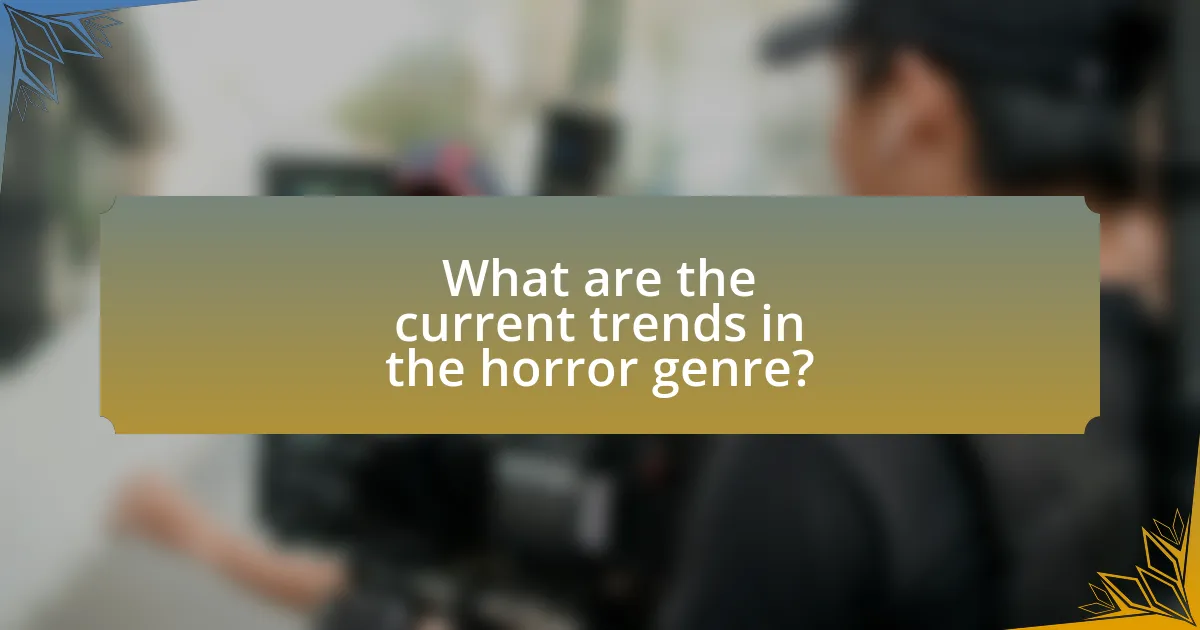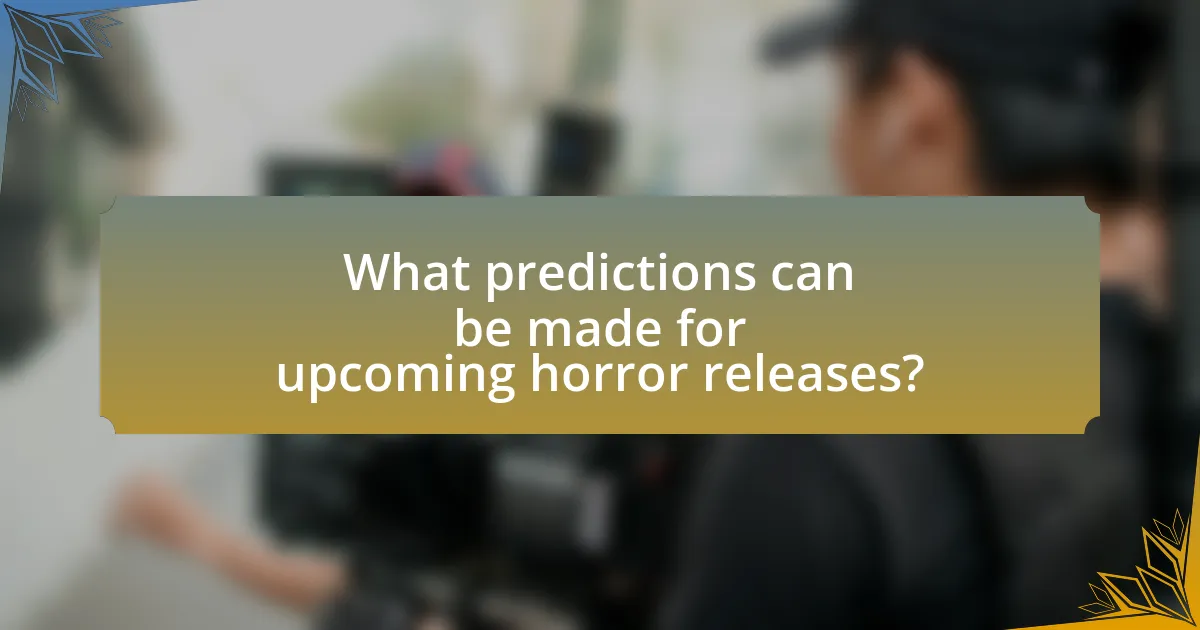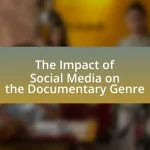The article focuses on the future of the horror genre, highlighting current trends and predictions for upcoming releases. Key trends include the rise of psychological horror, the incorporation of social commentary addressing issues like race and mental health, and the influence of technology on storytelling and distribution. Filmmakers are adapting to modern audiences by utilizing streaming platforms for wider access and experimenting with narrative structures, including interactive elements. The article also discusses the impact of binge-watching on character development and the importance of audience engagement in shaping future horror experiences.

What are the current trends in the horror genre?
Current trends in the horror genre include a rise in psychological horror, the incorporation of social commentary, and the use of technology in storytelling. Psychological horror focuses on the mental and emotional states of characters, creating tension through internal conflicts rather than external threats. Films like “Hereditary” and “The Babadook” exemplify this trend by exploring themes of grief and trauma.
Additionally, horror narratives increasingly address social issues such as race, gender, and mental health, as seen in “Get Out” and “The Invisible Man,” which reflect contemporary societal anxieties. The integration of technology, particularly through streaming platforms, allows for diverse storytelling formats, including limited series and interactive experiences, expanding the audience’s engagement with horror content.
These trends indicate a shift towards more nuanced and reflective horror that resonates with modern viewers, as evidenced by box office successes and critical acclaim for films that embrace these elements.
How are filmmakers adapting horror to modern audiences?
Filmmakers are adapting horror to modern audiences by incorporating contemporary social issues and utilizing advanced technology in storytelling. For instance, films like “Get Out” and “The Invisible Man” address themes of racial tension and domestic abuse, respectively, reflecting current societal concerns. Additionally, the use of virtual reality and augmented reality in projects like “The Walking Dead: Onslaught” enhances viewer immersion, making the horror experience more engaging. These adaptations not only resonate with modern viewers but also leverage innovative techniques to elevate the genre, ensuring its relevance in today’s cinematic landscape.
What themes are becoming more prevalent in contemporary horror films?
Contemporary horror films are increasingly focusing on themes of social commentary, mental health, and technology’s impact on society. These themes reflect current societal anxieties, such as the fear of isolation and the consequences of digital life. For instance, films like “Get Out” and “Hereditary” explore racial tensions and familial trauma, respectively, while “Cam” and “Unfriended” delve into the psychological effects of online identities and cyberbullying. This trend indicates a shift from traditional horror tropes to narratives that resonate with modern audiences, highlighting real-world issues and fears.
How is technology influencing the production of horror movies?
Technology is significantly influencing the production of horror movies by enhancing visual effects, sound design, and distribution methods. Advanced CGI and practical effects allow filmmakers to create more realistic and terrifying imagery, as seen in films like “It” (2017), which utilized cutting-edge technology to bring Pennywise to life. Additionally, immersive sound design techniques, such as Dolby Atmos, heighten the audience’s emotional response, making horror experiences more intense. Furthermore, streaming platforms like Netflix and Hulu have revolutionized distribution, enabling independent filmmakers to reach wider audiences without traditional studio backing, as evidenced by the success of films like “The Haunting of Hill House.” These technological advancements are reshaping how horror stories are told and experienced, making them more engaging and accessible.
What role does streaming play in the future of horror releases?
Streaming plays a pivotal role in the future of horror releases by providing a platform for diverse storytelling and wider audience access. As traditional box office models decline, streaming services like Netflix and Hulu have become primary distributors for horror films, allowing for innovative narratives that may not have thrived in theaters. For instance, the success of films like “Bird Box” and “The Platform” demonstrates how streaming can propel unique horror concepts to mainstream popularity, achieving millions of views within days of release. This shift not only democratizes content creation but also caters to the growing demand for horror, as evidenced by a 2021 report from the Motion Picture Association, which noted that horror films accounted for 15% of all streaming content consumed.
How are streaming platforms changing the distribution of horror films?
Streaming platforms are significantly altering the distribution of horror films by providing wider access and immediate availability to diverse audiences. These platforms, such as Netflix and Hulu, enable filmmakers to bypass traditional theatrical releases, allowing for a more direct connection with viewers. For instance, Netflix’s release of “Bird Box” in 2018 garnered over 45 million views within its first week, demonstrating the potential for rapid audience engagement. Additionally, streaming services often invest in original horror content, which not only diversifies the genre but also encourages experimentation with unconventional narratives and styles. This shift has led to an increase in the production of niche horror films that may not have found a place in mainstream cinema, thus expanding the overall landscape of horror storytelling.
What impact does binge-watching have on horror storytelling?
Binge-watching significantly influences horror storytelling by allowing for deeper character development and more intricate plotlines. This format enables creators to explore complex narratives over multiple episodes, enhancing suspense and emotional engagement. For instance, series like “The Haunting of Hill House” utilize binge-watching to build tension gradually, leading to a more immersive experience. Research indicates that viewers who binge-watch are more likely to form emotional connections with characters, which can amplify the impact of horror elements (Nielsen, 2020). Thus, binge-watching shapes horror storytelling by fostering richer narratives and heightened viewer investment.

What predictions can be made for upcoming horror releases?
Upcoming horror releases are likely to focus on psychological themes, innovative storytelling techniques, and the integration of technology. The trend towards psychological horror has been evident in recent successful films, such as “Hereditary” and “Midsommar,” which emphasize character-driven narratives and emotional depth. Additionally, the use of virtual reality and augmented reality in horror experiences is expected to grow, as seen in projects like “The Walking Dead: Saints & Sinners,” which have shown how immersive technology can enhance fear and engagement. Furthermore, the rise of streaming platforms has led to an increase in horror content, allowing for diverse voices and unique perspectives to emerge, as demonstrated by the success of series like “The Haunting of Hill House.” These factors suggest that upcoming horror releases will continue to evolve, pushing boundaries and exploring new dimensions of fear.
Which sub-genres of horror are expected to rise in popularity?
Psychological horror and folk horror are expected to rise in popularity. Psychological horror focuses on the mental and emotional states of characters, creating tension through internal conflict rather than external threats. This sub-genre has gained traction due to its ability to resonate with contemporary societal anxieties, as seen in films like “Hereditary” and “The Babadook.” Folk horror, which draws on rural settings and local myths, is also experiencing a resurgence, as evidenced by the success of movies like “Midsommar” and “The Witch.” These films tap into a growing interest in cultural narratives and the exploration of human fears rooted in tradition and community.
What characteristics define the emerging sub-genres?
Emerging sub-genres in horror are characterized by their innovative blending of traditional horror elements with contemporary themes, such as psychological depth, social commentary, and technological influences. These sub-genres often explore complex human emotions and societal issues, reflecting current anxieties and cultural shifts. For instance, the rise of “elevated horror” emphasizes character development and existential dread, as seen in films like “Hereditary” and “The Babadook,” which prioritize psychological realism over jump scares. Additionally, the incorporation of digital technology and social media in narratives, as exemplified by “Unfriended” and “Cam,” showcases how emerging sub-genres adapt to modern communication methods and fears. This evolution indicates a shift towards more nuanced storytelling that resonates with contemporary audiences.
How are cultural shifts influencing these predictions?
Cultural shifts are significantly influencing predictions in the horror genre by altering audience expectations and thematic preferences. For instance, the rise of social justice movements has led to a demand for horror narratives that address systemic issues, such as racism and gender inequality, reflecting societal concerns. This shift is evidenced by films like “Get Out,” which critiques racial dynamics, and “The Babadook,” which explores mental health and motherhood, both of which have garnered critical acclaim and commercial success. Additionally, the increasing acceptance of diverse voices in storytelling is reshaping horror, as seen in the works of filmmakers like Jordan Peele and Nia DaCosta, who bring fresh perspectives and experiences to the genre. These cultural changes are driving the industry to adapt, resulting in predictions that emphasize inclusivity and relevance in upcoming horror releases.
What innovations in storytelling can we expect in future horror films?
Future horror films are expected to innovate storytelling through the integration of interactive narratives and advanced technology. Interactive storytelling, where viewers can influence plot outcomes, is gaining traction, as seen in projects like “Bandersnatch,” which allows audience choices to shape the narrative. Additionally, the use of virtual reality (VR) and augmented reality (AR) is anticipated to create immersive experiences that engage viewers on a deeper emotional level, enhancing the horror experience. These innovations reflect a shift towards more participatory and technologically enriched storytelling methods in the horror genre.
How are filmmakers experimenting with narrative structures?
Filmmakers are experimenting with narrative structures by employing non-linear storytelling, multiple perspectives, and interactive elements. For instance, films like “Memento” and “The Witch” utilize fragmented timelines to create suspense and engage viewers in piecing together the story. Additionally, projects such as “Bandersnatch” from the “Black Mirror” series introduce interactive narratives, allowing audiences to make choices that affect the storyline. These innovative approaches challenge traditional linear narratives and enhance viewer engagement, reflecting a shift in how stories are told in cinema.
What role does audience interactivity play in future horror experiences?
Audience interactivity will significantly enhance future horror experiences by allowing participants to influence narrative outcomes and emotional engagement. This interactivity fosters a deeper connection between the audience and the story, creating a personalized experience that can amplify fear and suspense. For instance, immersive horror games and interactive films, such as “Until Dawn” and “Bandersnatch,” demonstrate how audience choices can lead to varied endings, thereby increasing replay value and emotional investment. Research indicates that interactive storytelling can lead to heightened emotional responses, making horror experiences more impactful and memorable.

How can audiences prepare for the future of horror films?
Audiences can prepare for the future of horror films by staying informed about emerging trends and actively engaging with the genre. This involves following industry news, participating in horror film festivals, and exploring independent filmmakers who often push creative boundaries. Research indicates that horror films are increasingly incorporating social commentary and psychological elements, reflecting societal fears and anxieties. For instance, films like “Get Out” and “Hereditary” have successfully blended traditional horror with deeper themes, indicating a shift in audience expectations. By understanding these trends, viewers can better appreciate and anticipate the evolving landscape of horror cinema.
What should viewers look for in upcoming horror releases?
Viewers should look for innovative storytelling and unique concepts in upcoming horror releases. As the genre evolves, filmmakers are increasingly blending horror with other genres, such as psychological thriller and dark comedy, to create fresh narratives that challenge traditional tropes. For instance, films like “Get Out” and “Hereditary” have successfully incorporated social commentary and psychological depth, which resonate with contemporary audiences. Additionally, advancements in technology, such as virtual reality and immersive experiences, are becoming more prevalent, enhancing viewer engagement and creating a more visceral experience. These trends indicate a shift towards more complex and thought-provoking horror, making it essential for viewers to seek out films that push boundaries and offer new perspectives.
How can audiences identify quality horror content in a crowded market?
Audiences can identify quality horror content in a crowded market by evaluating critical reviews, audience ratings, and unique storytelling elements. Critical reviews from reputable sources often highlight the strengths and weaknesses of horror films, providing insights into their quality. For instance, films that receive high ratings on platforms like Rotten Tomatoes or Metacritic typically indicate a positive reception among critics and viewers alike. Additionally, unique storytelling elements, such as innovative plots or character development, can set quality horror apart from generic offerings. Research shows that originality in horror narratives correlates with higher audience engagement and satisfaction, as evidenced by successful films like “Get Out,” which received acclaim for its fresh approach to the genre.
What resources are available for staying updated on horror trends?
To stay updated on horror trends, individuals can utilize a variety of resources including dedicated horror websites, social media platforms, and industry publications. Websites such as Bloody Disgusting and Dread Central provide news, reviews, and analysis specifically focused on horror content. Social media platforms like Twitter and Instagram feature accounts dedicated to horror news, allowing users to follow real-time updates and discussions. Additionally, industry publications such as Variety and The Hollywood Reporter often cover trends in horror films and television, providing insights into upcoming releases and market shifts. These resources collectively offer comprehensive coverage of the evolving landscape of horror entertainment.
What are some tips for engaging with the horror community?
To effectively engage with the horror community, actively participate in discussions on platforms like Reddit, Facebook groups, and horror forums. Engaging in these spaces allows individuals to share opinions, recommend films, and discuss themes, which fosters a sense of belonging. Additionally, attending horror conventions and film festivals provides opportunities to meet creators and fans, enhancing connections within the community. Research indicates that participation in niche communities increases social interaction and satisfaction, as seen in studies on online engagement in genre-specific groups.
How can fans participate in discussions about horror trends?
Fans can participate in discussions about horror trends by engaging in online forums, social media platforms, and attending genre-specific events. Online forums such as Reddit and specialized horror websites allow fans to share insights and opinions on emerging trends. Social media platforms like Twitter and Instagram enable fans to follow industry professionals and participate in conversations using relevant hashtags. Additionally, attending conventions and film festivals provides opportunities for fans to interact with creators and fellow enthusiasts, fostering discussions about current and future horror trends. These methods are supported by the growing online community and the increasing number of horror events, which highlight the active engagement of fans in the genre.
What events or platforms foster connections among horror enthusiasts?
Conventions and online platforms foster connections among horror enthusiasts. Events like Comic-Con, HorrorHound Weekend, and FrightFest provide opportunities for fans to meet creators, attend panels, and participate in discussions. Online platforms such as Reddit, Facebook groups, and dedicated horror forums allow enthusiasts to share content, discuss films, and connect with like-minded individuals globally. These gatherings and digital spaces enhance community engagement and facilitate the exchange of ideas and recommendations within the horror genre.


